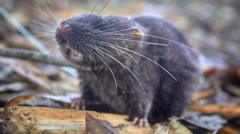The lush landscapes of Alto Mayo in Peru have become the backdrop for a remarkable scientific discovery, with 27 new species identified during a recent expedition. Among these are a distinctive amphibious mouse with webbed feet and a bizarre blob-headed fish. The exploration was conducted by the non-profit organization Conservation International in collaboration with local indigenous communities, particularly the Awajún people.
Conservation International reported the possibility of uncovering up to 48 additional species pending further investigation. "Finding so many new mammals and vertebrates is astounding, especially in a locale impacted by humans," remarked Trond Larsen, senior director at the organization. The region, known for its diverse ecosystems and high human population density, faces environmental challenges including deforestation and agriculture.
Yulisa Tuwi, an Awajún participant in the research, emphasized the importance of the findings for their culture and resource management. This research helps the Awajún community deepen their understanding of the intricacies within their ecosystems, a knowledge they have cultivated over generations.
In addition to the amphibious mouse, scientists discovered a new species of dwarf squirrel, measuring only 14cm — notably smaller than its UK grey counterpart. Researchers also cataloged eight fish species, three amphibians, and ten butterfly types during the expedition.
One intriguing finding was the so-called "blob-headed" fish, a new bristlemouth armoured catfish, which features an enlarged head previously unfathomed by researchers—but recognized by local indigenous communities.
Moreover, the expedition revealed a spiny mouse, characterized by stiff guard hairs that resemble hedgehog spines, and a semi-aquatic mouse that preys on aquatic insects. The discoveries underline the region's ecological significance and the essential connection between traditional knowledge and modern-day conservation efforts.
Conservation International reported the possibility of uncovering up to 48 additional species pending further investigation. "Finding so many new mammals and vertebrates is astounding, especially in a locale impacted by humans," remarked Trond Larsen, senior director at the organization. The region, known for its diverse ecosystems and high human population density, faces environmental challenges including deforestation and agriculture.
Yulisa Tuwi, an Awajún participant in the research, emphasized the importance of the findings for their culture and resource management. This research helps the Awajún community deepen their understanding of the intricacies within their ecosystems, a knowledge they have cultivated over generations.
In addition to the amphibious mouse, scientists discovered a new species of dwarf squirrel, measuring only 14cm — notably smaller than its UK grey counterpart. Researchers also cataloged eight fish species, three amphibians, and ten butterfly types during the expedition.
One intriguing finding was the so-called "blob-headed" fish, a new bristlemouth armoured catfish, which features an enlarged head previously unfathomed by researchers—but recognized by local indigenous communities.
Moreover, the expedition revealed a spiny mouse, characterized by stiff guard hairs that resemble hedgehog spines, and a semi-aquatic mouse that preys on aquatic insects. The discoveries underline the region's ecological significance and the essential connection between traditional knowledge and modern-day conservation efforts.


















